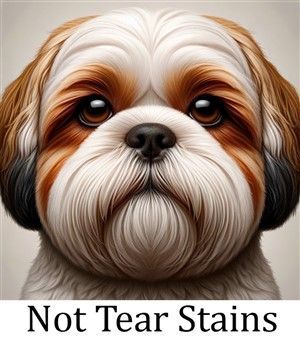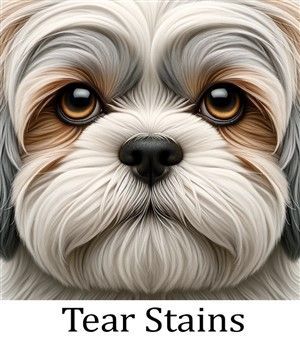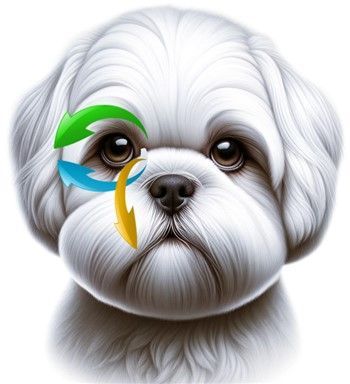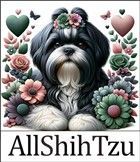Shih Tzu Tear Stains
Overview
Tear stains manifest as discoloration in the hair under or around a dog's eyes, displaying shades of pink, red, rust, or brown. The affected hair may have a dry, slightly crunchy texture akin to straw, although softer hairs can also exhibit these stains.
The root cause of tear stains typically traces back to various elements introduced into the area around the eyes through a dog's tears. They can occur more frequently if regular eye care grooming tasks are not performed.
Breeds with distinct facial features, like Shih Tzus, known for their short snouts and shallow eye sockets, are particularly susceptible to tear stains, especially visible on lighter fur. Whether your Shih Tzu's tear stains are mild, moderate, or severe, understanding and addressing the issue is key to restoring their charming appearance. Let's explore effective solutions to tackle tear stains and enhance your Shih Tzu's snazzy look.
Please note: AllShihTzu is reader-supported, and some of the product suggestions on this page are affiliate links. As an Amazon Associate we earn from qualifying purchases. This is at no extra cost to you and helps keep this site running.
How to Know if It's Tear Stains
Here are some ways to know the difference:
Not tear stains:
If the color around the eyes closely matches color found on other parts of the coat and the hairs are soft and appear healthy, it is most likely natural coloring.

Points to tear stains:
- The color under the eyes was not present at all when the Shih Tzu was a puppy, but developed as he reached the 6 month mark or up.
- The color grew in intensity and/or spread out as the dog matured.
- The hairs have a hardened or 'crispy' texture to them, that makes combing the hairs difficult.
- There is noticeable eye discharge.
- The hairs appear damp.
- Sometimes, but not always, there will also be other face staining. If so, this will be discoloration around the mouth, chin, and/or beard.

How to Prevent Tear Stains
Step #1 Eliminate the Causes
Understanding and addressing the common causes of tear stains is crucial:
- Diet: Avoid foods with artificial additives, corn, or wheat, as they can trigger allergic reactions leading to excessive tearing. Opt for high-quality food with no additives and non-allergenic grains like rice, or grain-free formulas.
- Water Quality: High mineral content and contaminants in tap water can contribute to tear staining. Use filtered or bottled spring water.
- Moisture Management: Damp facial hair fosters yeast growth. Keep your Shih Tzu's face dry, especially after drinking or eating wet food.
- Tear Discharge: Iron in tears can cause staining. Address any excessive discharge potentially caused by allergies or eye disorders.
- Red Yeast: This is usually caused by the above issues of moisture or excessive tears.
- Skipped Facial Cleanings: Daily wiping of the face, especially after meals, prevents stain development. Use hypoallergenic, fragrance-free grooming wipes regularly.
- Feeding and Drinking Equipment: Replace plastic bowls with stainless steel or ceramic to avoid contact reactions.
- Health Check: Address health issues causing excessive tearing, such as allergies or eyelash problems, with a vet consultation.
Step 2: Daily Maintenance
Daily maintenance involves wiping the eye area, one to three times a day. This alone will not remove deep-set stains (that is covered ahead under 'How to Remove Tear Stains on a Shih Tzu'), but once the stains are gone, or to prevent them from occurring in the first place, this step is vital. And it's easy!
Instructions:
1) Have a good wipe, like Earthbath Specialty Eye Wipes, which is has a great texture and gentle cleansers.
2) Swipe over the eye, under the eye and then down from the inner eye toward the nose. Refer to the diagram below. If there is a lot of discharge or buildup, flip the wipe over and swipe again, following the below 1, 2, 3 motions.

3) Use a new, clean wipe for the second eye. Do not use a dirty wipe.
How to Remove Stubborn Tear Stains on a Shih Tzu
Remember:
- Address Underlying Causes: Without resolving all causes, even the best tear stain removers have limited effectiveness. And if you do not eliminate the causes, you'll be fighting a never-ending uphill battle.
What to Avoid:
Avoid potentially dangerous home remedies such as bleach, homemade boric acid and cornstarch mixtures, milk of magnesia concoctions, lemon, Tums, vinegar in drinking water, and buttermilk powder (which does not work at all).
Recommended Products:
1) One of our favorite products is the aforementioned Earthbath wipes. Given enough time and used daily, it will gradually cleanse the hairs of the stains, and as new hairs grow it will prevent them from becoming stained.
2) If you have used a quality wipe faithfully for several weeks and do not see any improvement, it'll be time to try something else.
We like Eye Envy's Step 2. Their Step 1 is a cleanser, which is a good one, but will do the same as your Shih Tzu's daily wipes and shampoo during baths. Their Step 3 is a powder that protects the hairs by repelling tears and moisture and it can be a good product to use as well (if you do, note that you can apply it with a child's toothbrush and do not necessarily need to use a special applicator).
Prescribed Medications
In cases of severe staining or in instances of an underlying health issue that is directly causing the staining, such as a stubborn red yeast infection, a veterinarian might recommend antibiotic or antifungal treatments.
It's important to be aware that tetracycline is not suitable for puppies that are still growing their adult teeth. Administration of this medication to young dogs can lead to permanent staining of teeth yet to emerge.
Are You a Member of AllShihTzu?
Join us and become a free AllShihTzu member; it's absolutely free. You'll receive a Welcome eBooklet and our newsletters that keep you up-to-date on all important info regarding your Shih Tzu. It's the best way for us to stay in touch, so we hope you'll join us today.
You May Also Be Interested in:
Smart Gadgets for Shih Tzu Care - Clever tools, handy devices, and helpful doodads that can make daily routines easier and a whole lot more fun for both you and your little guy or gal.
How to Fix the Top 5 Shih Tzu Physical Discomforts - Addressing the top 5 concerns of: Sensitive skin, tummy troubles, cold intolerance, breathing discomfort, and mobility issues in Shih Tzu dogs. Help your Shih Tzu start feeling better today.
Shih Tzu Do's and Don'ts - A quick, super-helpful summary of the 3 most vital do's and the 3 most important don'ts when taking care of a Shih Tzu puppy or dog. It's always a good idea to reassess things, for optimal health and well-being.

